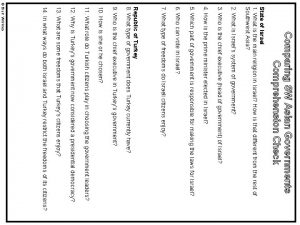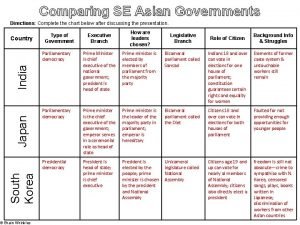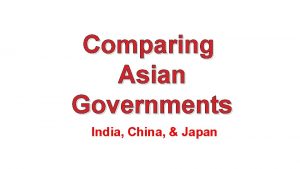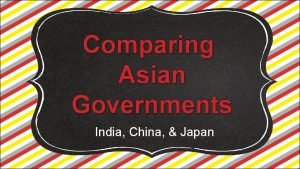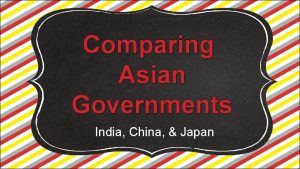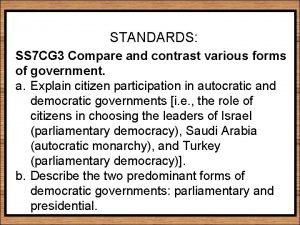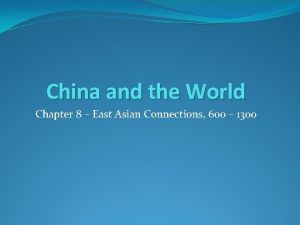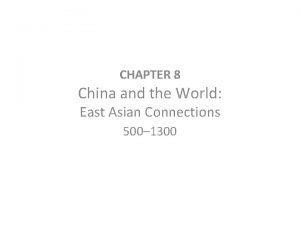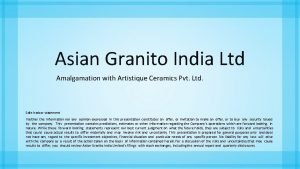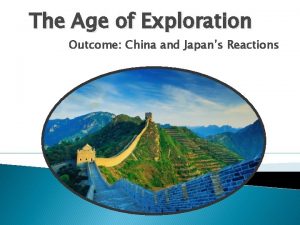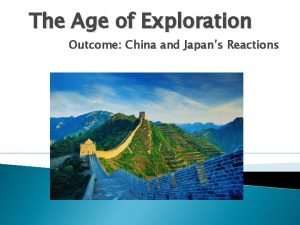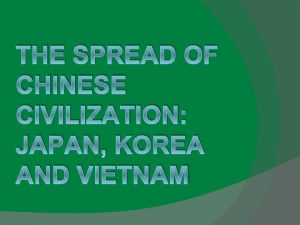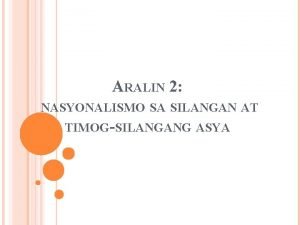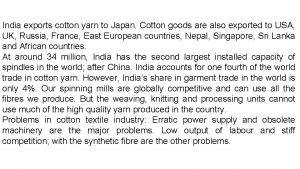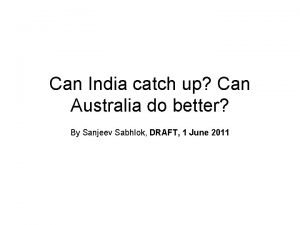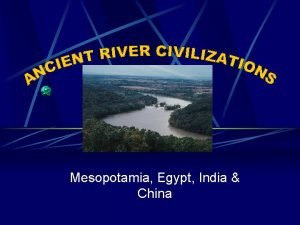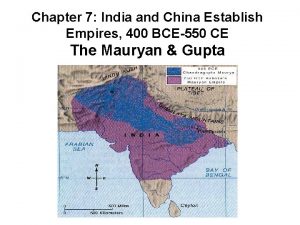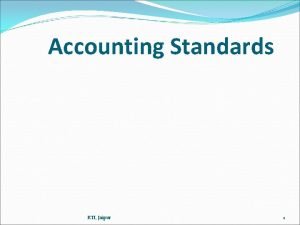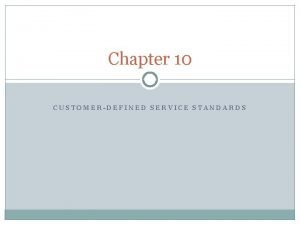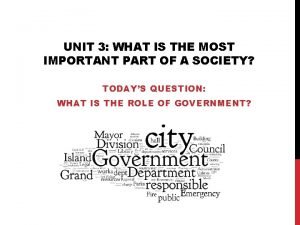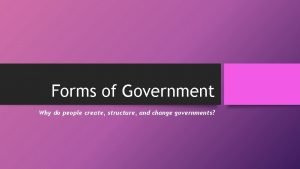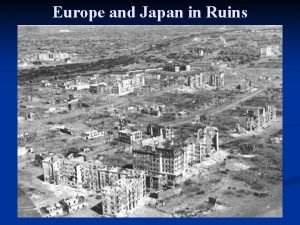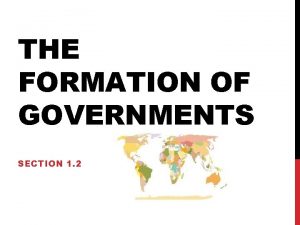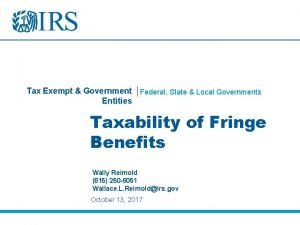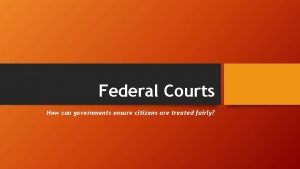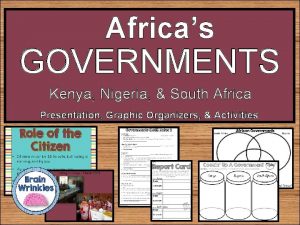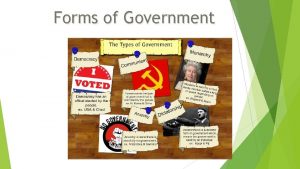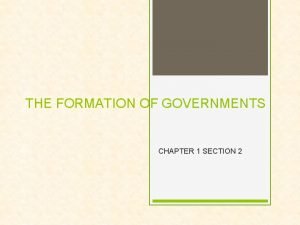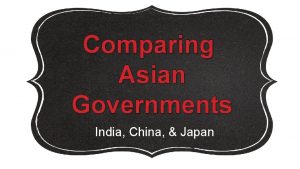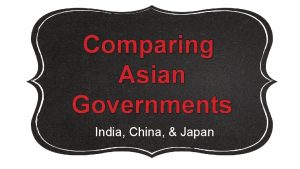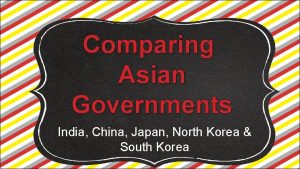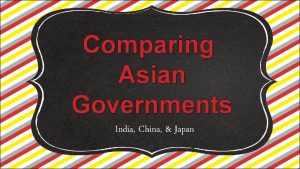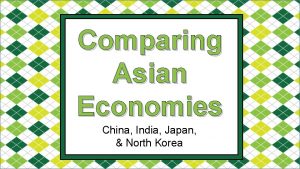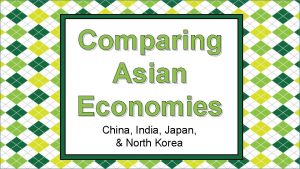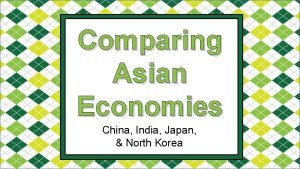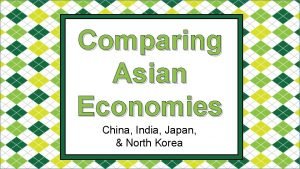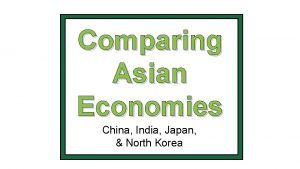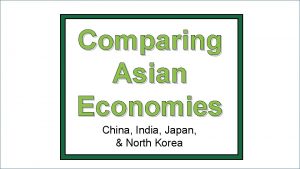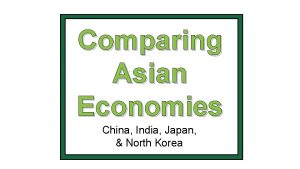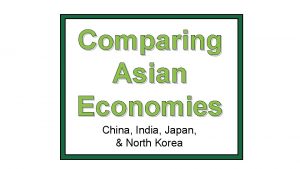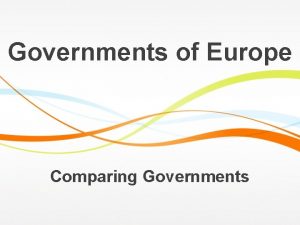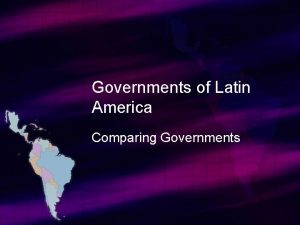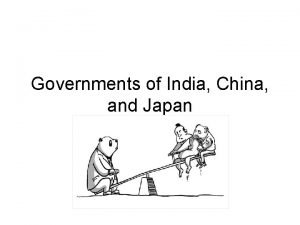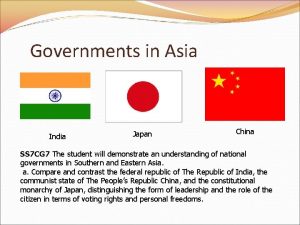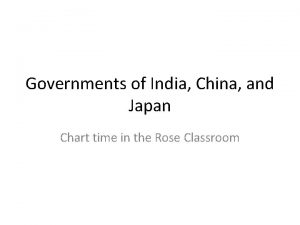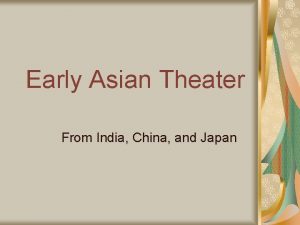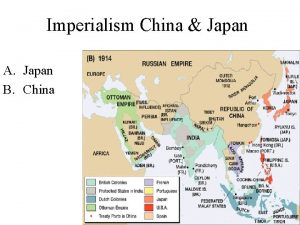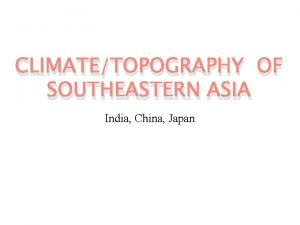Comparing Asian Governments India China Japan Standards SS


































- Slides: 34

Comparing Asian Governments India, China, & Japan

Standards SS 7 CG 6 The student will compare and contrast various forms of government. a. Describe the ways government systems distribute power: unitary, confederation, and federal. b. Explain how governments determine citizen participation: autocratic, oligarchic, and democratic. c. Describe the two predominant forms of democratic governments: parliamentary and presidential. SS 7 CG 7 The student will demonstrate an understanding of national governments in Southern and Eastern Asia. a. Compare and contrast the federal republic of The Republic of India, the communist state of The People’s Republic China, and the constitutional monarchy of Japan, distinguishing the form of leadership and the role of the citizen in terms of voting rights and personal freedoms.

Let’s Review Government Systems – Who has the power? • Unitary--power is held by one central authority • Confederation--association of independent states that agree to certain limitations on their freedoms by joining together • Federal--power is divided between central authority & several regional authorities

Let’s Review Government Types – how do citizens participate? • Autocracy-- 1 person possesses unlimited power & citizens have limited role in government • Oligarchy-- small group exercises control & citizens have limited role in government • Democracy--supreme power is vested in the people & exercised by them directly or indirectly through a system of representation involving free elections

Let’s Review Two Types of Democratic Governments: • Parliamentary– citizens elect members of Parliament, and then the members select the leader o Leader works with or through the legislature • Presidential--system of government in which the leader is constitutionally independent of the legislature; citizens directly elect leader o Leader works separate from legislature

Republic of India Federal Republic

Federal System • India has a federal system, which means that the national government and the state governments SHARE power. • There are 28 states and 7 union territories in India.

Federal Governments

Leadership 1. Prime Minister: holds the most political power; the prime minister is the head of government. 2. President: is the chief of state; mostly performs ceremonial duties (holds no real political power).

Manmohan Singh India’s Prime Minister

Pranab Mukherjee India’s President

How Leaders Are Chosen • Prime Minister: is the leader of the majority party in India’s Parliament; indirectly elected by the Indian people. • President: elected by an electoral college consisting of elected members of Parliament and the legislatures of the states for a five-year term.

Legislature = the central authority of a government • India’s legislature is called Parliament. • The citizens of India vote for members of Parliament. o Members of Parliament belong to many different political parties.

Legislature • Parliament is the country’s bicameral legislature. • It consists of: 1. Lok Sabha “House of the People” (545 seats) – members are elected by Indian citizens. 2. Rajya Sabha “Council of States” (245 seats) – members are elected by the

Parliamentary Democracy • Whichever political party has the most members in the legislature selects the Prime Minister. • This is the major difference between a Presidential Democracy and a Parliamentary Democracy! o Parliamentary Democracy – legislature (Parliament) chooses Head of Government (Executive Leader) • Citizens vote for members of Parliament, members choose the Prime Minister.

Role of the Citizen • The Indian Constitution of 1950 granted many rights and personal freedoms to Indian citizens. • All Indians over the age of 18 are guaranteed the right to vote. • Indians also have freedom of speech, freedom of religion, and freedom of assembly. • They are also given the right to conserve their language and culture.

Voting lines in Delhi– December 2013

Japan Parliamentary Constitutional Monarchy

Japan’s Diet Building in Tokyo

Unitary System • Japan has a unitary system, which means that the national (central) government holds all of the power. • The prefectures (like states) are under central government control. • There are 47 prefectures in Japan.

Unitary Governments

Leadership • Emperor: ceremonial position; holds no political power—power was limited by the constitution. • Prime Minister: holds the most political power; the prime minister is the head of government.

How Leaders Are Chosen • Emperor: hereditary position. • Prime Minister: is the leader of the majority party in Japan’s Diet (parliament); indirectly elected by the Japanese people.

Legislature • The Japanese Diet is the country’s bicameral legislature. • It consists of: 1. House of Representatives (480 seats) – members elected to serve four-year terms. 2. House of Councillors (242 seats) – members elected to serve six-year terms. *The Prime Minister has the right to dissolve the House of Representatives at any time.

Parliamentary Democracy • Japan has a parliamentary democracy. • Japanese citizens elect members of the House of Representatives. • The leader of the majority party of the House of Representatives becomes the Prime Minister. • The citizens indirectly elect the leader.

Role of the Citizen • Japanese citizens can vote after age 20. • Japan’s constitution of 1947 established rights and personal freedoms for Japan’s citizens, including freedom of speech and religion, equal rights for women, and equal education for all.

People’s Republic of China Communist State

Great Hall of the People in Beijing

Unitary System • China has a unitary system, which means that the national (central) government holds all of the power. • The provinces are under central government control.

Leadership • President: head of state; largely a ceremonial office that holds little political power. • Premier: head of government – highest ranking administrative official in China’s government.

How Leaders Are Chosen • President: elected* by National People’s Congress for a five-year term. • Premier: nominated by the president and confirmed by the National People’s Congress. • *Chinese Communist Party is the only legal party, and officially sanctioned candidates run

Legislature • The National People’s Congress is the country’s unicameral legislature. • The number of seats is based on China’s population. • As of the most recent election, there were 2, 987 seats. • Candidates are selected and approved by the government before the people can vote for them. • Members serve five-year terms. • Only members of the CCP are elected.

Oligarchy • Oligarchy means “government by the few”. • A political party or group takes over a government and makes all decisions. • This type of government is similar to an autocracy. • China’s government could be considered an oligarchic government because the leaders of the Chinese Communist Party control most of what goes on in the country.

Role of the Citizen • China’s communist government has a history of violating the personal freedoms of Chinese citizens by denying them basic rights such as freedom of speech and religion. • Even though the constitution gives every person over 18 the right to vote, these rights are mostly meaningless because they are only allowed to vote for members of the Chinese Communist Party. • The government chooses the candidates and then dictates what they do once they are “elected”.
 Governments comprehension check
Governments comprehension check Comparing asian governments
Comparing asian governments Is japan a unitary state
Is japan a unitary state Comparing asian governments
Comparing asian governments Comparing asian governments
Comparing asian governments Comparing sw asia governments answers
Comparing sw asia governments answers Comparing sw asian governments
Comparing sw asian governments Comparing african governments
Comparing african governments Chapter 8 china and the world
Chapter 8 china and the world Chapter 8 china and the world east asian connections
Chapter 8 china and the world east asian connections Asian granito india ltd turnover
Asian granito india ltd turnover The age of exploration outcome china and japan's reactions
The age of exploration outcome china and japan's reactions The age of exploration outcome china and japan's reactions
The age of exploration outcome china and japan's reactions Spread of china's literature to heian japan and korea
Spread of china's literature to heian japan and korea Ano ang bahaging ginampanan ni emperador mutsuhito sa japan
Ano ang bahaging ginampanan ni emperador mutsuhito sa japan India export yarn to japan
India export yarn to japan Comparative development experiences of india and china
Comparative development experiences of india and china India china
India china Map of mesopotamia egypt india and china
Map of mesopotamia egypt india and china Ubicacion geografica de egipto y mesopotamia
Ubicacion geografica de egipto y mesopotamia Chapter 7 india and china establish empires
Chapter 7 india and china establish empires Ancient india vs ancient china
Ancient india vs ancient china Rti jaipur
Rti jaipur Hard customer defined standards
Hard customer defined standards Different kind of governments
Different kind of governments Why do people create
Why do people create Two effects of allied bombing raids on japan.
Two effects of allied bombing raids on japan. Centre region council of governments
Centre region council of governments The formation of governments 1-2
The formation of governments 1-2 Are local governments tax exempt
Are local governments tax exempt Are city governments tax exempt
Are city governments tax exempt How can governments ensure citizens are treated fairly
How can governments ensure citizens are treated fairly How do the governments of kenya and nigeria compare?
How do the governments of kenya and nigeria compare? How are governments classified
How are governments classified The formation of governments 1-2
The formation of governments 1-2
